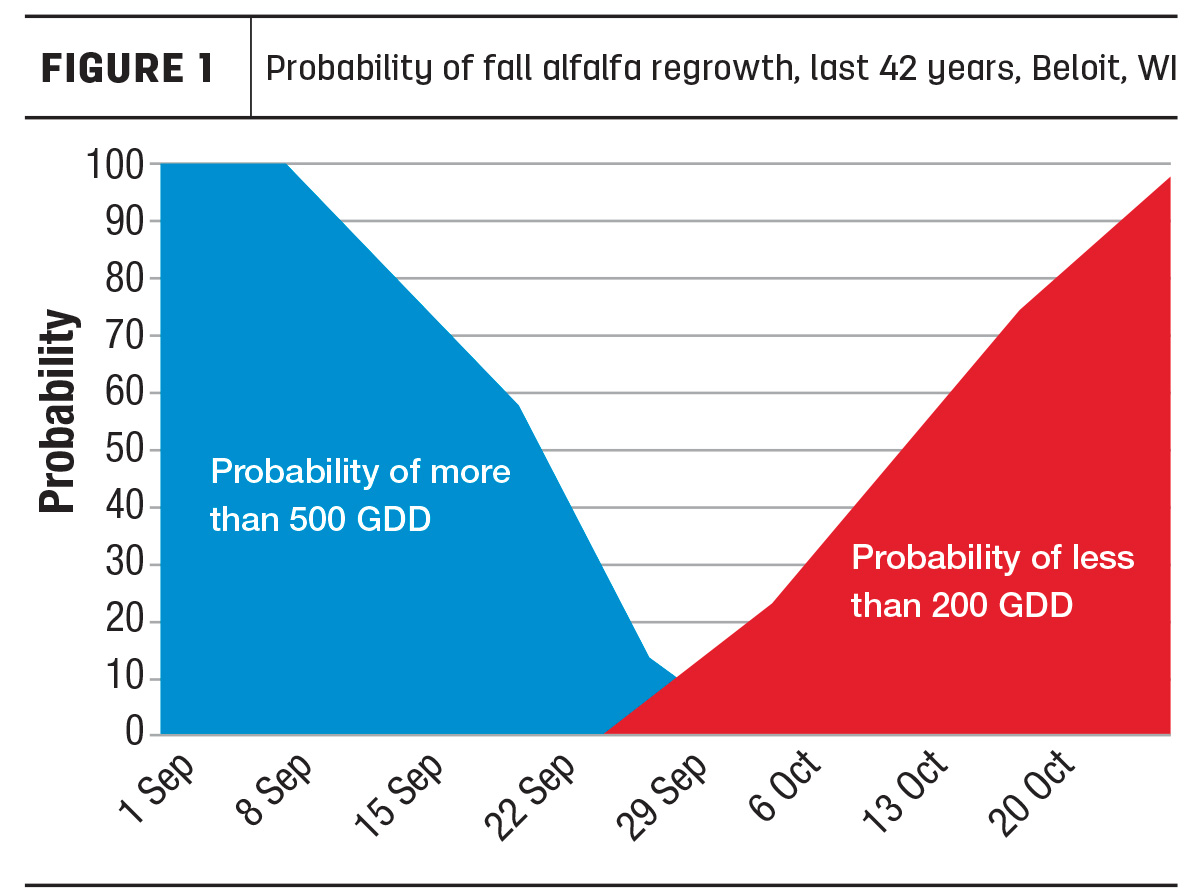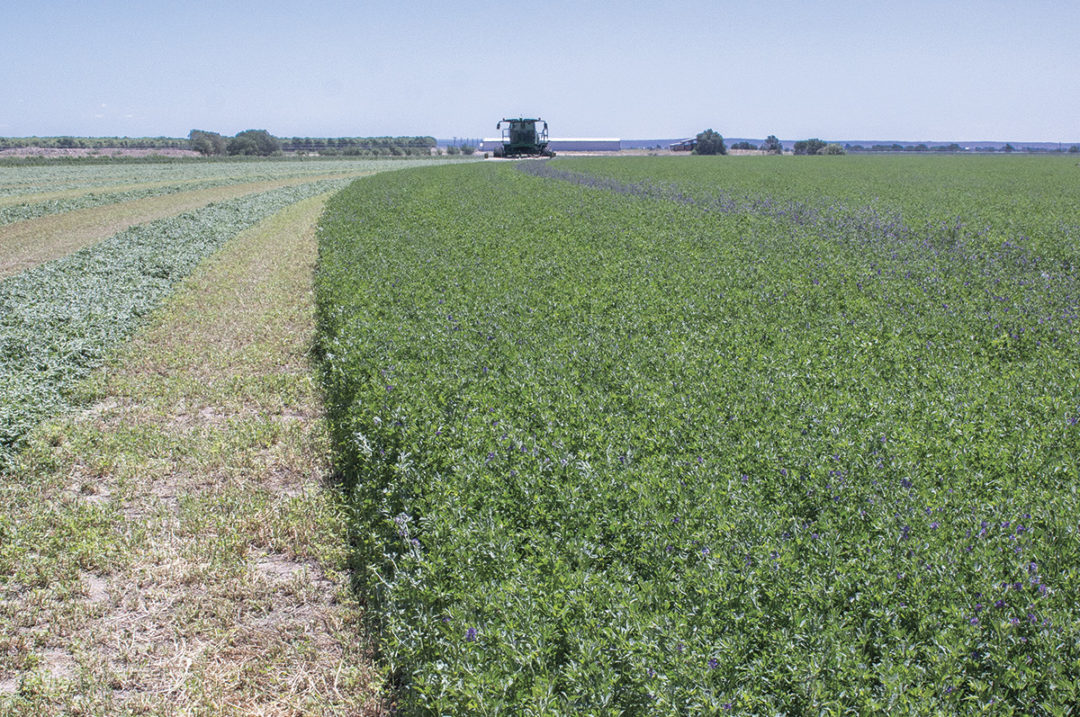Now when the weather is warm is when we should begin preparing alfalfa for winter, if we want good winter survival and high yield next spring.
First, consider whether or not the stand is worth keeping. Stem density, not plant density, determines yield potential. Fifty-five stems per square foot are required for maximum yield (25 stems per square foot in non-irrigated, dryland regions). You can count cut ends after mowing. If, for example, the stand has 40 stems per square foot, then one would expect a 25% yield reduction from maximum. If you decide to keep an irrigated stand with less than 55 stems per square foot, not only will yield be reduced, but thin stands will tend to have more weed problems. You should consider controlling weeds, either this fall or next spring to avoid lower-quality forage than desired.
If a stand is marginal, keep the benefits in mind of legume credits and rotational benefit to the succeeding crop. With over $300 per acre rotational benefit to corn, it may be most economical to terminate a thin stand and replant new fields rather than to keep a low-yielding field.
Fall management for winter survival
If we want good winter survival and rapid greenup for good yield next year, alfalfa must either be cut:
- Early enough in the fall to allow it to regrow and replenish root carbohydrates and proteins or
- So late that the alfalfa does not regrow or use any root carbohydrates.
This has resulted in the recommendation of a “no-cut” window during September for most Northern states. Research has helped define this window by indicating that alfalfa needs 500 growing degree days after the last summer cutting to regrow sufficiently for good winter survival and yield the next year. GDD is calculated as:
((Daily maximum temperature - daily minimum temperature) / by 2) - 41ºF, accumulated until a killing frost of 24ºF.
Thus, the date is not important but the temperature following cutting and alfalfa regrowth is. This means we can cut as late as 500 GDD to accumulate without hurting winter survival.
On the other extreme, we can also cut so late that little regrowth occurs. Cutting when 200 GDD or less will occur indicates that there will be insufficient regrowth to use significant amounts of root carbohydrates. These plants would also have good winter survival. It is important to remember that we do not need to wait for a killing frost to take the last cutting. We must only wait until it is so cool that little or no regrowth will occur.
In summary, we want either to take the last alfalfa harvest early enough that regrowth and root replenishment occurs or so late that little to no growth occurs. Calculating both probabilities tells us the risk of winter injury or kill due to harvesting at different dates during September and October. This data was calculated for Wisconsin sites where we had 42 years of weather history (Figure 1). Data is presented for Beloit, Wisconsin, on the Wisconsin-Illinois border. The probability of accumulating 500 GDD after each week is blue. The traditional no-cut date was Sept. 7, where the probability of 500 GDD was 100%. Some farmers would cut a week or two later where the probability of 500 GDD was 80% and 60%, respectively. These farmers can have good winter survival if the weather cooperates.

The probability of accumulating less than 200 GDD is represented by the red area. Farmers wishing to take a late fall cutting should pay attention to this line. Many farmers will choose a late fall cutting this year due to the high price of hay. Removing alfalfa forage late in the season will also result in killing many alfalfa weevils overwintering in the field, reducing the weevil problem next year.
The top line in the graph is the probability of accumulating either 500 GDD or less than 200 GDD after the indicated date and shows the probability of no injury or kill to alfalfa stands harvested on that date. We should assume that the graphs are for very winter-hardy varieties (winter survival score of 2 or less) and that less winter-hardy varieties would be at more risk.
Note that the worst time to harvest alfalfa in the fall in this region is Sept. 22 to Oct 15.
Alfalfa/grass mixtures should be treated like alfalfa if they are over 50% alfalfa (where the alfalfa stems will hold up the grass leaves) and should be treated like grass if the stand is less than 50% alfalfa. Generally, the principle for managing cool-season grass stands for winter survival is to harvest so that the grass enters the winter with less than 6 inches of growth. The reason is that, if harvested at least once during the growing season, the late-fall growth is all leaves, and these will form a mat under the snow. Snow mold will often grow under the mat and may kill the grass.
Cutting management
If all alfalfa cuttings are taken at 28-day intervals or at the bud stage, root carbohydrate content is replenished to a lesser extent after each cutting. An old recommendation is to let at least one cutting (preferably the third or fourth cutting) go to early flower to rebuild stand condition by increasing root carbohydrate levels. This is still a good idea for conventional alfalfa to improve winter survival and increase yield for first cutting next year.
However, if one is growing HarvXtra alfalfa and harvesting on a 35-day interval or longer, the need for a delayed third or fourth cutting is not necessary, since more carbohydrates are placed back into the roots with the longer harvest interval at each cutting. Trials have shown better winter survival and more rapid spring greenup from 35-day cutting intervals of HarvXtra compared to continuous 28-day cutting intervals.
Late-summer fertilization (during August) should be done to replace nutrients removed by the alfalfa forage, if the soil was at optimum at the beginning of the year. Optimum soil test levels of soil pH (6.5 or higher) and potassium can also enhance winter survival. Assuming that one started with optimum soil tests at the beginning of the year, one can calculate nutrient removal by considering how much each ton of hay removes. Alfalfa removes 6 pounds phosphorus, 50 pounds potassium and 6 pounds sulfur for each dry matter ton of forage removed. Whether or not the amount removed needs to be replaced with fertilizer depends on the nutrient levels in the soil and application in other sources, such as manure or irrigation water.
Where irrigation is available, consider that the most critical irrigation is the late-summer or autumn irrigation. Good levels of soil moisture at this time (1) permit foliage regrowth and root carbohydrate accumulation for overwintering, (2) lessen rapid temperature changes that damage roots, (3) prevent crown and root drying and (4) provide stored moisture for the next growing season. Dry soils during winter often cause stand declines. Maintain soil water content between 50% to 70% of the available water-holding capacity. The deeper portion of the soil profile can be refilled in this off-season period.
It is important to at least partially fill the soil profile in late winter from either rain, snowmelt or irrigation while alfalfa is dormant and before soil temperatures warm to above 60oF. A dry soil will restrict root growth that should begin before aboveground growth and reduce yield of first harvest.
The above management considerations will optimize winter survival and yield of first cutting next year.










